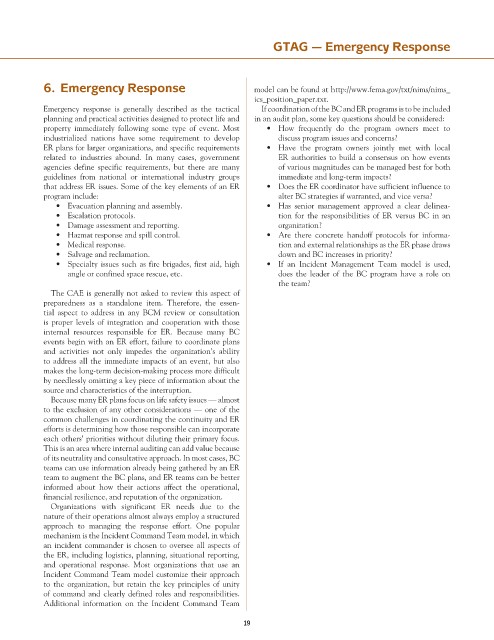Page 566 - ITGC_Audit Guides
P. 566
GTAG — Emergency Response
6. Emergency Response model can be found at http://www.fema.gov/txt/nims/nims_
ics_position_paper.txt.
Emergency response is generally described as the tactical If coordination of the BC and ER programs is to be included
planning and practical activities designed to protect life and in an audit plan, some key questions should be considered:
property immediately following some type of event. Most • How frequently do the program owners meet to
industrialized nations have some requirement to develop discuss program issues and concerns?
ER plans for larger organizations, and specific requirements • Have the program owners jointly met with local
related to industries abound. In many cases, government ER authorities to build a consensus on how events
agencies define specific requirements, but there are many of various magnitudes can be managed best for both
guidelines from national or international industry groups immediate and long-term impacts?
that address ER issues. Some of the key elements of an ER • Does the ER coordinator have sufficient influence to
program include: alter BC strategies if warranted, and vice versa?
• Evacuation planning and assembly. • Has senior management approved a clear delinea-
• Escalation protocols. tion for the responsibilities of ER versus BC in an
• Damage assessment and reporting. organization?
• Hazmat response and spill control. • Are there concrete handoff protocols for informa-
• Medical response. tion and external relationships as the ER phase draws
• Salvage and reclamation. down and BC increases in priority?
• Specialty issues such as fire brigades, first aid, high • If an Incident Management Team model is used,
angle or confined space rescue, etc. does the leader of the BC program have a role on
the team?
The CAE is generally not asked to review this aspect of
preparedness as a standalone item. Therefore, the essen-
tial aspect to address in any BCM review or consultation
is proper levels of integration and cooperation with those
internal resources responsible for ER. Because many BC
events begin with an ER effort, failure to coordinate plans
and activities not only impedes the organization’s ability
to address all the immediate impacts of an event, but also
makes the long-term decision-making process more difficult
by needlessly omitting a key piece of information about the
source and characteristics of the interruption.
Because many ER plans focus on life safety issues — almost
to the exclusion of any other considerations — one of the
common challenges in coordinating the continuity and ER
efforts is determining how those responsible can incorporate
each others’ priorities without diluting their primary focus.
This is an area where internal auditing can add value because
of its neutrality and consultative approach. In most cases, BC
teams can use information already being gathered by an ER
team to augment the BC plans, and ER teams can be better
informed about how their actions affect the operational,
financial resilience, and reputation of the organization.
Organizations with significant ER needs due to the
nature of their operations almost always employ a structured
approach to managing the response effort. One popular
mechanism is the Incident Command Team model, in which
an incident commander is chosen to oversee all aspects of
the ER, including logistics, planning, situational reporting,
and operational response. Most organizations that use an
Incident Command Team model customize their approach
to the organization, but retain the key principles of unity
of command and clearly defined roles and responsibilities.
Additional information on the Incident Command Team
19

